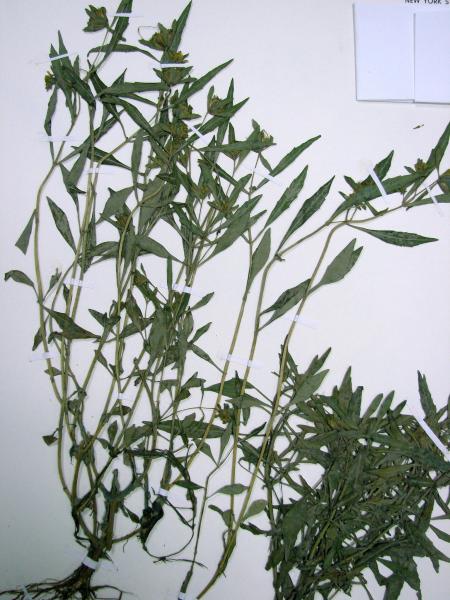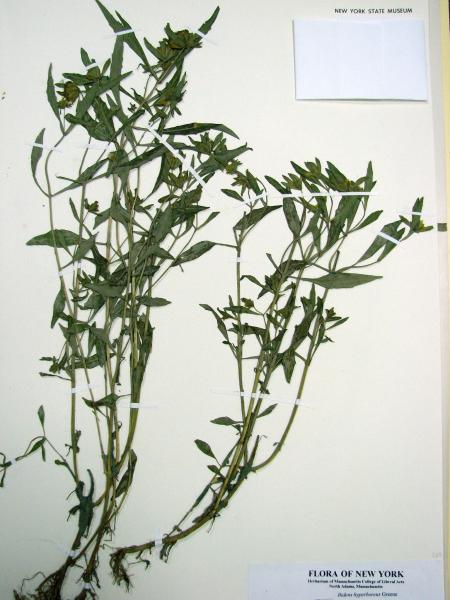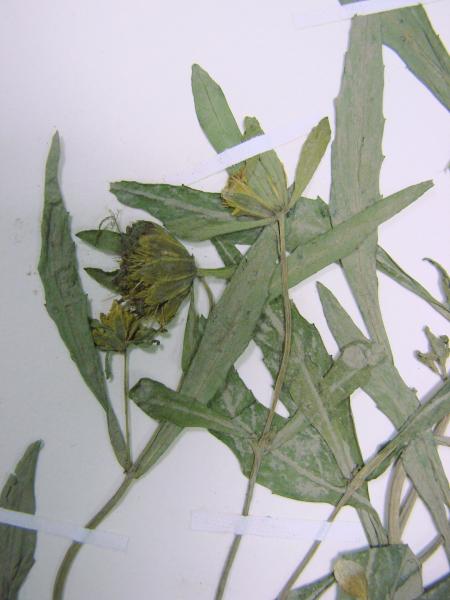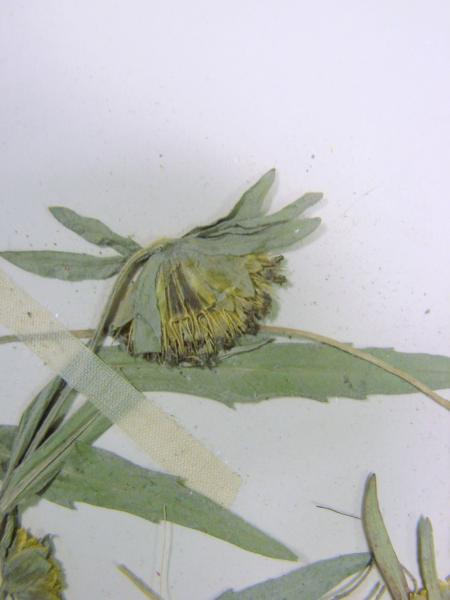Estuary Beggar-ticks
Bidens hyperborea var. hyperborea None
- Class
- Dicotyledoneae (Dicots)
- Family
- Asteraceae (Aster Family)
- State Protection
- Endangered
Listed as Endangered by New York State: in imminent danger of extirpation in New York. For animals, taking, importation, transportation, or possession is prohibited, except under license or permit. For plants, removal or damage without the consent of the landowner is prohibited.
- Federal Protection
- Not Listed
- State Conservation Status Rank
- SNA
Not Applicable - A state conservation status rank is not applicable because the species is not a suitable target for conservation activities (e.g., species is a hybrid, a domesticated species, not native to New York, an accidental or infrequent visitor outside of its normal range, a transient or migrant just passing through the state, or a species with only unconfirmed or doubtful reports).
- Global Conservation Status Rank
- G4T2T4
Imperiled or Vulnerable globally, or Apparently secure - Conservation status of the subspecies/variety is uncertain, and could range from high to moderate risk of extinction due to rarity or other factors, or could be uncommon but not rare globally. More information is needed to assign either T2, T3 or T4. (The species as a whole is apparently secure globally.)
Summary
Did you know?
Estuary beggar-ticks is part of a confusing array of Bidens species that grow in the estuaries of the Hudson River. Surveying for this species is difficult because bloom time is short and its tidal habitat is available only for a few hours a day during low tide. Consequently we have very little information on the distribution of the species in New York.
State Ranking Justification
One historical population has been rediscovered and two new populations have been found since 1985. Six additional historical populations from the 1930s have not been rediscovered.
Short-term Trends
Each existing population has only been surveyed once and follow-up survey work needs to be done to understand how these plants are doing in the short term.
Long-term Trends
This plant was never common in New York with only seven historical records from the 1930s. One of the historical records has been rediscovered and two new populations have been found. This species has always survived at low levels in New York and that trend continues.
Conservation and Management
Threats
This species is threatened by phragmites that has taken over some of the marsh habitat where it grows. More survey work needs to be done to find out if present populations still remain or if phragmites has eliminated their habitat completely. Recreational boating may have some effect on populations as docks and landings are constructed near its habitat.
Conservation Strategies and Management Practices
Phragmites needs to be controlled in and around current populations.
Research Needs
Research into habitat preference could discover why this species is not more common in the large expanses of tidal marshes along the Hudson River.
Habitat
Habitat
In New York this species is known only from freshwater tidal mud flats and marshes, associated with Scirpus americana, Scirpus validus, Zizania aquatica, Bidens bidentoides and Sparganium eurycarpum (New York Natural Heritage Program 2007). Estuaries (Fernald 1970). Estuaries (Gleason 1952).
Associated Ecological Communities
- Freshwater intertidal mudflats
(guide)
A sparsely vegetated community characterized by low rosette-leaved aquatics. This community occurs on exposed intertidal mudflats where the water is fresh (salinity less than 0.5 ppt). This community is best developed where mudflats are nearly level so that broad expanses are exposed at low tide. The plants are completely submerged in 0.9 to 1.2 m (3 to 4 ft) of water at high tide and they are usually coated with mud.
- Freshwater tidal marsh
(guide)
A marsh community that occurs in shallow bays, shoals, and at the mouth of tributaries of large tidal river systems, where the water is usually fresh (salinity less than 0.5 ppt), and less than 2 m (6 ft) deep at high tide. Typically there are two zones in a freshwater tidal marsh: a low-elevation area dominated by short, broadleaf emergents bordering mudflats or open water, and a slightly higher-elevation area dominated by tall grass-like plants.
Associated Species
- Bidens bidentoides (estuary beggar-ticks)
- Eutrochium maculatum
- Schoenoplectus americanus (chair-maker's bulrush)
- Schoenoplectus tabernaemontani (soft-stemmed bulrush)
- Sparganium eurycarpum (giant bur-reed)
- Zizania aquatica
Range
New York State Distribution
In New York this plant is found only in freshwater tidal marshes and mud flats on the lower Hudson River upstream as far as Dutchess County. Historically it was collected as far north as Albany County.
Global Distribution
This plant occurs from Quebec and Ontario through the Maritime provinces and coastal New England States, reaching its southern limit in New York.
Identification Comments
General Description
Delmarva Beggar-ticks is an annual, opposite-leaved herb of tidal shores and mudflats. It has coarsely-toothed leaves which narrow at the base into slender petioles. Its flower heads are entirely discoid (lacking petal-like ray flowers), about 5 to 15mm wide, and erect. The disk corolla is 4-lobed, and the fruit are achenes. These achenes have awns with antrorse (upward-pointing) barbs along the margins (visible under magnification).
Best Life Stage for Proper Identification
Mature flowering heads are required to positively identify this species.
Similar Species
Bidens laevis and Bidens cernua have a mature disk that is wider than 1.5 cm, 5-lobed disc flower corollas, and fruiting heads that are often nodding. Bidens hyperborea, B. laevis and B. cernua all have sessile leaves and achenes with retrorse (downward pointing) barbs. Bidens cernua has a stem that is soft and usually hispid (B. bidentoides has glabrous stems).
Best Time to See
Bidens hyperborea flowers from mid-August through September, and fruits from mid-September into October.
- Flowering
- Fruiting
The time of year you would expect to find Estuary Beggar-ticks flowering and fruiting in New York.
Estuary Beggar-ticks Images
Taxonomy
Estuary Beggar-ticks
Bidens hyperborea var. hyperborea None
- Kingdom Plantae
- Phylum Anthophyta
- Class Dicotyledoneae
(Dicots)
- Order Asterales
- Family Asteraceae (Aster Family)
- Order Asterales
- Class Dicotyledoneae
(Dicots)
- Phylum Anthophyta
Synonyms
- Bidens eatonii Fern. [Misapplied to some New York reports.]
- Bidens hyperborea var. colpophila (Fern. & St. John) Fern.
Comments on the Classification
All of our Bidens hyperborea are variety hyperborea.
Additional Resources
Best Identification Reference
Flora of North America Editorial Committee. 2006. Flora of North America North of Mexico. Vol. 21. Magnoliophyta: Asteridae, Part 8: Asteraceae, part 3. Oxford Univ. Press, New York. xxii + 616 pp.
Other References
Fernald, M.L. 1950. Gray's manual of botany. 8th edition. D. Van Nostrand, New York. 1632 pp.
Gleason, Henry A. and A. Cronquist. 1991. Manual of Vascular Plants of Northeastern United States and Adjacent Canada. The New York Botanical Garden, Bronx, New York. 910 pp.
Holmgren, Noel. 1998. The Illustrated Companion to Gleason and Cronquist's Manual. Illustrations of the Vascular Plants of Northeastern United States and Adjacent Canada. The New York Botanical Garden, Bronx, New York.
New York Natural Heritage Program. 2024. New York Natural Heritage Program Databases. Albany, NY.
Reschke, Carol. 1990. Ecological communities of New York State. New York Natural Heritage Program, New York State Department of Environmental Conservation. Latham, NY. 96 pp. plus xi.
Weldy, T. and D. Werier. 2010. New York flora atlas. [S.M. Landry, K.N. Campbell, and L.D. Mabe (original application development), Florida Center for Community Design and Research http://www.fccdr.usf.edu/. University of South Florida http://www.usf.edu/]. New York Flora Association http://newyork.plantatlas.usf.edu/, Albany, New York
Weldy, Troy W. and David Werier. 2005. New York Flora Atlas. [S.M. Landry, K.N. Campbell, and L.D. Mabe (original application development), Florida Center for Community Design and Research. University of South Florida]. New York Flora Association, Albany, NY. Available on the web at (http://newyork.plantatlas.usf.edu/).
Links
About This Guide
Information for this guide was last updated on: January 13, 2009
Please cite this page as:
New York Natural Heritage Program. 2024.
Online Conservation Guide for
Bidens hyperborea var. hyperborea.
Available from: https://guides.nynhp.org/estuary-beggar-ticks/.
Accessed April 18, 2024.



